Voices of Experience
John Lasater
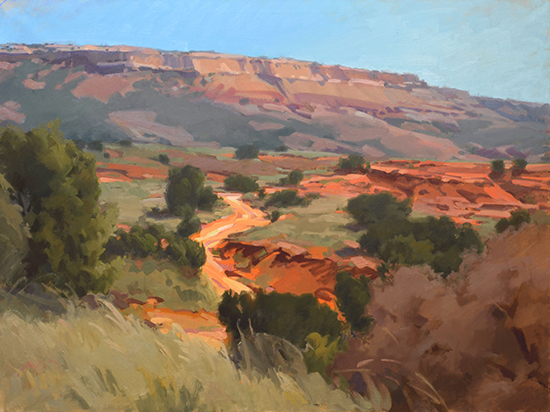
Colorful Palo Duro 36 x 48″ Oil
“It’s an act of trust each time we approach the easel,
and whether the result is pleasing or not,
we trust again the next time.
For painters, faith might be our greatest resource.”
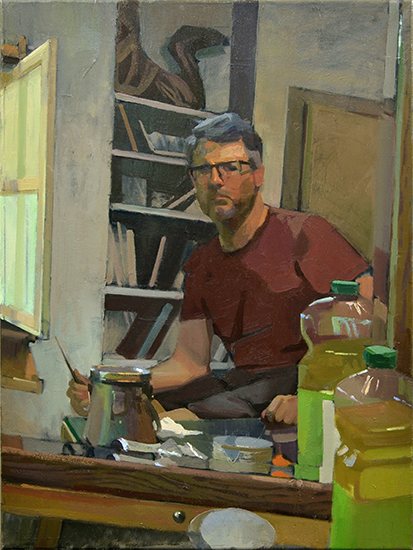
John Lasater walks the artist’s road with curiosity and experimentation, combining a love of art history with a contemporary awe of the light and landscape he finds in his travels both nationally and internationally.
Lasater has participated in plein air events across the country, often winning top honors. He combines his plein air work with a strong studio practice, adding portraiture and still life painting to his oeuvre. Teaching is a way to pass along his decades of observation and dedication to painting.
He wrote to us about the twists and turns taken in his life-long passion for art.
(Left) All I Need, 24 x 18″ , Oil
![]()
The first time I recall doing something artistic was when I was about six years old. My mom was pretty angry with me for a protest I threw, so I went to my room where it occurred to me that I could mend the disunity by making a drawing— so I did. Her tearful response created the association in my mind that I could use my drawing skills to do what words couldn’t do.
In my early teen years, my parents got me some private tutelage with an artist from our church. I went to about five sessions with her, and learned about the importance of gestural drawing and expression using charcoal. I also had an excellent art teacher, Beverly Arnold, during my seven years in private school.
My parents encouraged a practical education, so in college I studied Business Administration, but I always intended to be around some sort of creative business. My first wish was to enter the music industry in Nashville, but my life took a different turn and I ended up in the greeting card industry, which funny enough, ties back to my first artistic memory of using art for communication, since that is what greeting cards are all about.
It’s a long winding thread, but this is where the directional alignment happened. After a few years on the business side of greeting cards, I took a career risk and joined the creative department, first as a business person, but gradually I let my desires be known, and some good people at the company let me try my hand at conceptual design. My risk didn’t pay off, or so I thought. Soon I was dead weight and was part of a large layoff at the company.
For three months I worked at a gift business sanding wood blocks, until one day a friend showed up at my house and asked me to come work at a small startup advertising agency. He said he believed I would make an excellent graphic designer because he had seen some of my fledgling designs at the greeting card company. I was shocked, but super thankful. This meant that I could develop a portfolio, and maybe be a creative the rest of my career if everything went well!
I started that job immediately, and became proficient at graphic design. Funny enough, there is much to be learned about laying out shapes in a two-dimensional rectangular space. The experience became invaluable when I took up painting two years later.
The winding thread led me back to greeting cards (the same company that had laid me off) after two years at the agency, this time as a bona fide designer. One of my first interests was learning personal expression, now that I had adequate experience with design elements and principles. My best friend, Todd Williams, put on a painting workshop for the design department and, after battling with the juicy paint for three days, I was hooked. This was in the year 2000.
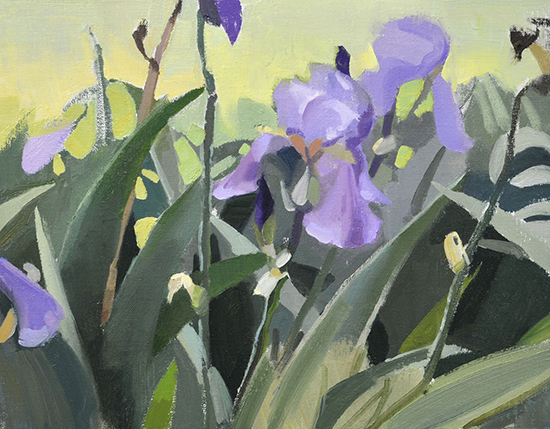
Irisism 11 x 14″ Oil
Over the next nine years of being a designer by day, I was a painter by night. Fortunately, I was able to use the Continued Education budget from work to go and take workshops. I went to three: a John Budicin plein air workshop at Fechin Art Workshops in New Mexico; a C.W. Mundy still life workshop at Scottsdale Artists School in Arizona; and, a Carolyn Anderson portrait workshop in New Harmony, Indiana.
From all three of those workshops, I learned that knowing oneself is more important than technique, and so I observed their techniques with a cautious eye. I valued their “why” rather than their “how”. This allowed me, more than anything, to begin the journey of becoming a more genuine artist.
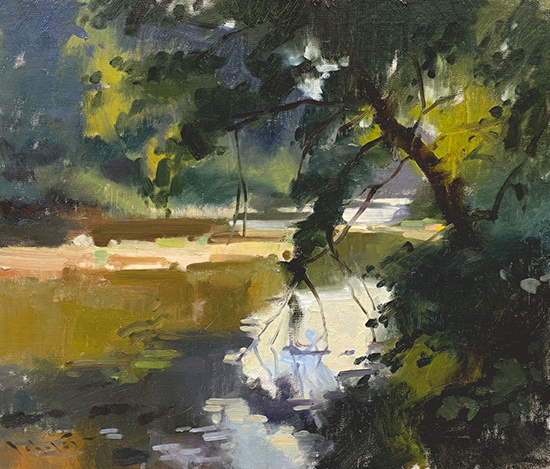
Heavenly Shade 14 x 12″ Oil
After the nine years of solid design work, I took a leap of faith in 2009. My wife and I had four kids already, and a large house to pay for, but in my heart I knew that my family could handle the ups and downs of entrepreneurship with me. Fortunately I was able to take on some freelance design work at first, but within three years, I was doing well enough at plein air events to focus all my time on painting.
In terms of education, I should mention one other story that’s more recent. About 2016 I had done well enough in my art career, that my dad approached me offering to fund an opportunity to study once more. I thought about it, and decided to go to the summer program JSS in Civita which is led by Israel Hershberg in Italy. Hershberg appeared to bridge the gap between the popular representational styles in the U.S. and the intellectual museum culture, which seem to be at odds with one another. I figured he would be able to answer some questions.
Hershberg opened up a world of art appreciation that was lacking from my self-taught education. Because of my time with him, I voraciously studied Western art history, and became proficient in understanding my art heritage. In 2017 Hershberg invited me to teach a workshop at his program, and if there were ever a feeling that I had reached the pinnacle of my painting career, albeit unworthily, that was it.
Were you also inspired by the landscape of Italy while you were there? What other landscapes have been particularly important to your painting?
Italy was truly inspirational. When I say that, many of the readers will assume I mean Tuscany or Lake Como or something. I mainly saw the landscape of the Lazio region north of Rome. The rocky and oak-covered hills reminded me of the Ozark Plateau I live in, yet with a timeless history revealed by the farms and towns, but also inexplicably visceral.
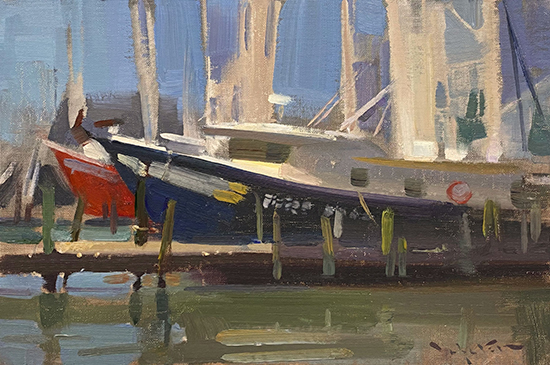
Ready to Launch 8 x 12″ Oil
From my years of attending plein air invitationals, I have some favorite places. One is Door County, Wisconsin. The sheer variety of subjects, and accessibility to them, is what I love the most. You can paint fishing boats in the morning, idyllic farmscapes in the day, and lakefront bluffs and beaches in the evening.
The Ozarks, where I live, are nothing special really. I noticed in my car trips eastward that the landscape of the eastern half of the U.S. is pretty much the same, with subtle differences, like the height of trees, or the height of the hills.
When I’m looking for some regional place to paint, I just drive around and find places that remind me of the grandeur I’ve seen in my travels or from the motifs of art history.
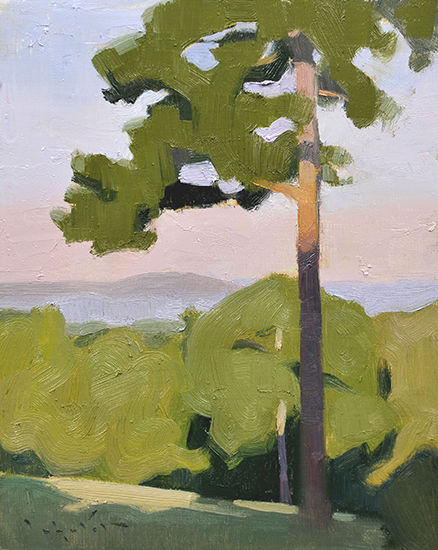
Ozark Morning 6 10 x 8″ Oil
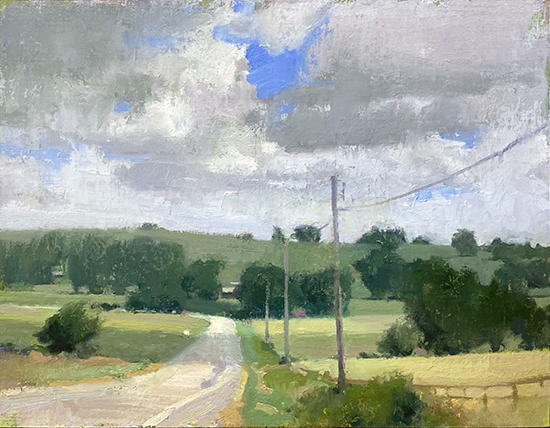
Ozark Paysage 14 x 18″ Oil
Have you explored other mediums in addition to oils?
And, would you tell us about your process when painting en plein air and how it differs when painting in the studio?
I was exposed to many mediums because of the greeting card environment, but I was more drawn to oils because of their richness. Having some background in watercolor has influenced my oil painting. I loved the iridescent color gradients that happen with watercolor, and so sometimes I like to smooth the oil paints across a shape to achieve a similar look. I also like the light-to-dark approach of watercolor, and have found ways to do that with oils as well, but only occasionally.
My outdoor process usually looks like this: 1) see the potential motif with my eyes, but broadly; 2) take out the phone camera and set it to black-and-white to find a design that I’m drawn to; 3) put the phone away and find the major gestures and lines using a thinned-out earth tone like burnt umber; 4) start by painting a color I’m certain about in an important juncture, and then judge the other colors by touching one to another in an ever-widening pattern. My process came from reading and re-reading Hawthorne on Painting.
Thumbnails are a great idea, especially when you have a confined panel size. However, I learned something new by painting outdoors internationally—if you start painting on a rolled canvas taped down to a board, or if you have an oversized panel, you can worry about where it’s cropped later. This has had fantastic results for me. I used to get down on myself when I’d get far into a painting before I realized I wanted a different composition, but I have so much freedom now. I often take a 12 x 12″ panel for plein air, tape it off once I’m confident about where to crop it, and then cut it after it’s had time to dry.
It’s much slower in the studio. After studying art history, I began believing that a painting turns out better if I show a little patience. I read about how historical painters would keep their canvases in flux for years, and I longed for my paintings to have that kind of complexity. Knowing when I’m losing motivation is key now, because waiting allows me to see the problems better. It’s a completely different mindset than I started with 22 years ago when painting was all emotion, and no intellect.
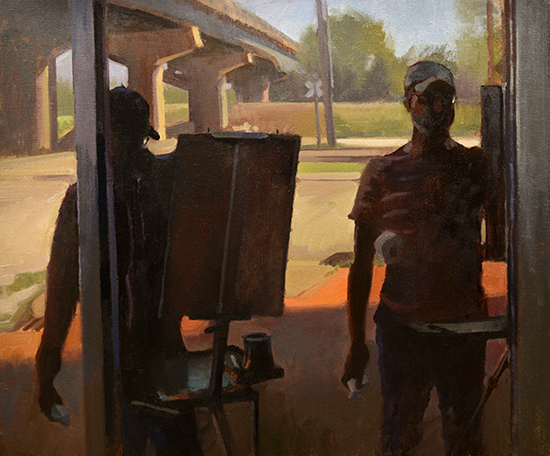
Self Reflection (with Jason Sacran) 20 x 24″ Oil
Nocturnes seem to be an important part of your subject matter. Would you tell us a little bit about how your palette changes when working in low-lite nighttime situations? What do you find inspirational about painting a nocturne?
Jason Sacran and I were two of the first to do it at plein air events sometime around 2010. It started as a way to make our display wall more interesting, and eventually became an accepted plein air genre around 2013. Nocturne painting is nothing new, but it seemed new to our patrons and peers.
The nocturne palette is minimal. I’m usually filling in much of the dark using thinned dark paints like Ultramarine Blue, Red Madder Deep and Burnt Umber. Some mix of these becomes a neutral that I can swing one way or another. I try not to use any white as a mixing agent till the very end for the center of a light source, or to enhance one of the lit shapes a little more. Generally Yellow Ochre works as a better mixing agent to lighten colors in a warmly lit scene, up until the end when I bring a little Cadmium Yellow or white into it.
There’s no way to describe the adjustments I would make at dusk or twilight. It’s pretty much the same, except the sky is a little lighter. At the Easton Plein Air event I did a dusk painting of a marina, and I had to return four times. It was killer hard. There was about a 15-minute window I was trying to capture, and then the values would literally reverse after the sky darkened so that the boats were light against dark instead of the other way around.
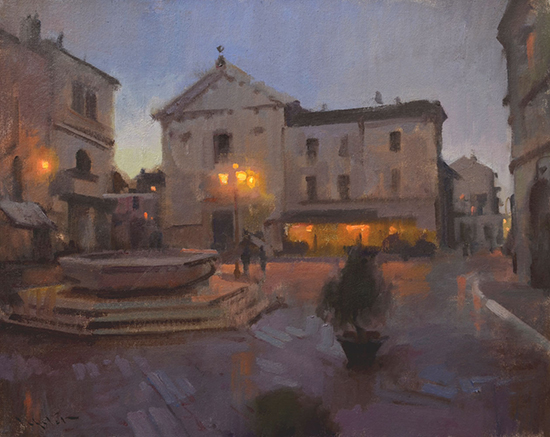
Old Piazza 16 x 20″ Oil
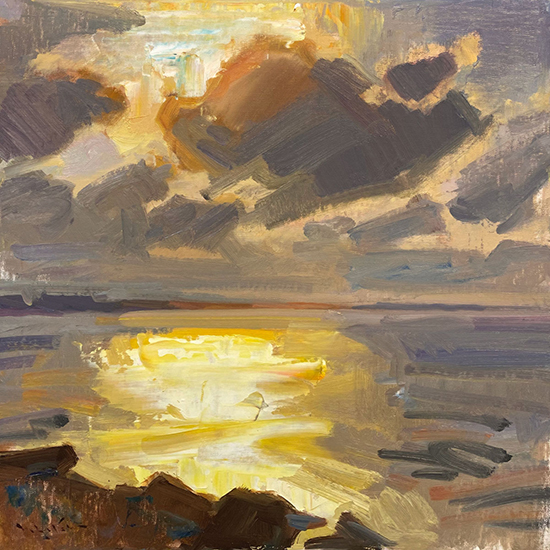
Symphony on the Bay 16 x 16″ Oil
Lasater’s palette includes these pigments:
Rembrandt Extra Fine Artist Oils in: Cadmium Yellow Light, Yellow Ochre, Cadmium Orange, Cadmium Red Light, Permanent Madder Deep, Ultramarine Blue Deep, King’s Blue, Phthalo Blue Green, Viridian Green, Permanent Yellowish Green, Sap Green, Burnt Umber, Burnt Sienna, Ivory Black, Titanium White.
Winsor & Newton Oils: Winsor Violet.
For more information on his materials and processes, Lasater has included a link to a series of six videos called “Tools, Marks, Edges and Textures” for purchase on his website: https://www.lasaterart.com/video.
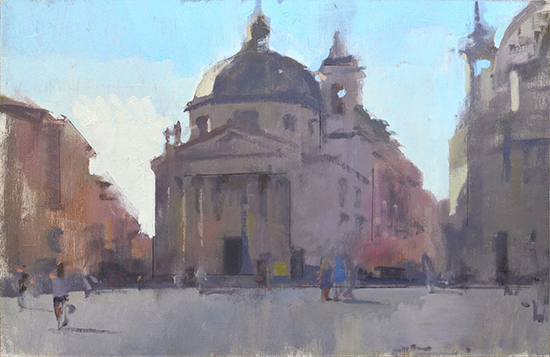
Two Roads 14 x 20″ Oil
Two Roads (above) was a fun one to develop because I would do a lot of push and pull with the paint. It was a difficult top-lit scene from Rome. When I started it, I blocked in with very crude childlike gestures, and then spent the rest of the time either reining it or backing up a couple steps. For the sake of the topic, I used a lot of my tools to demonstrate how redeemable an oil painting can be. Here are three steps in the execution of Two Roads:
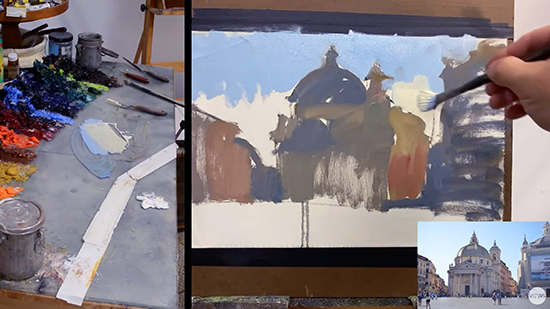
Step One – Two Roads
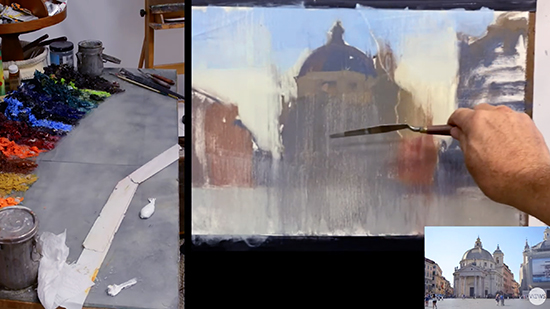
Step Two – Two Roads
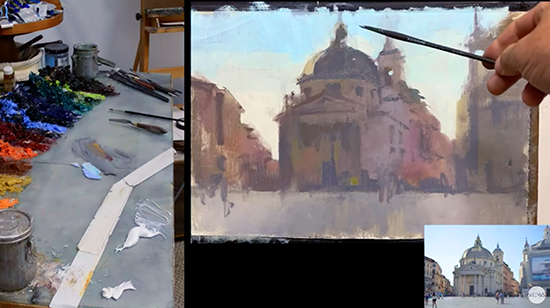
Step Three – Two Roads
What does your teaching calendar look like?
Since 2020, I’ve focused more on my Facebook mentoring community called “Views Community of Painters”, but I am starting to venture out more. Anyone is invited to join. There’s a retreat in October, a Mississippi workshop in November, another retreat in January or February and some more workshops coming up next year. For up to date information visit: https://www.lasaterart.com/workshops.
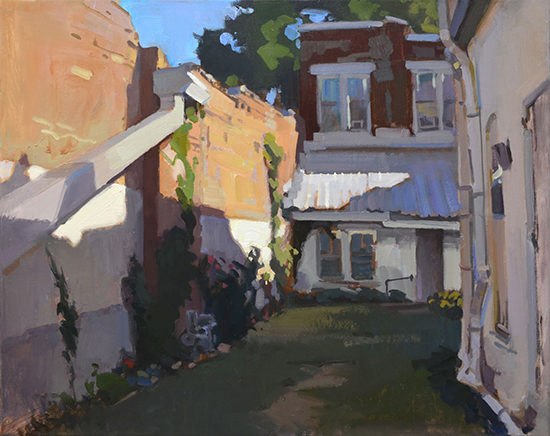
Hiddenaway 16 x 20″ Oil
Any words of wisdom you might give to beginning artists?
Every artist is so unique, but I feel safe in recommending these books to anyone: Hawthorne on Painting, The Art Spirit, and Whistler, A Life for Art’s Sake. Make little studies of paintings that speak to you, or even ones that confound you—there’s a reason some artists are remembered, even if you can’t see why. Follow generous artists instead of the showy ones. Follow great blogs like The Artist Road (- thanks, John), and journal the tidbits of wisdom that are revelatory.
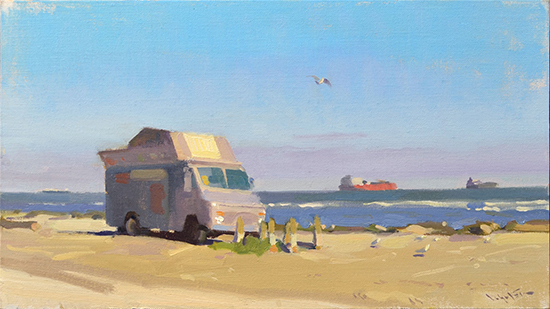
Tacos Con Arena (Tacos with Sand) 9 x 16″ Oil
And, just for fun, if you could sit down and have a long conversation over dinner with an artist from the past, who would you choose, and why?
Mmmm, I think, Edward Hopper. I haven’t seen a lot written about him, and I’d want to ask him about being representational in the modern age. There are others I’d love to have dinner with, but I’d probably turn into Chris Farley from the SNL skit where he was supposed to interview famous people and instead geeked out and told them his favorite memories of their movies while they awkwardly bobbed their head.
![]()
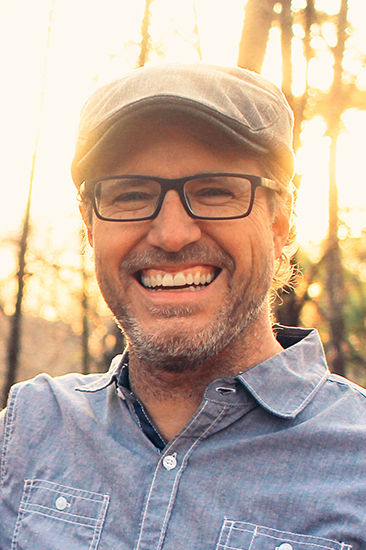
To see more of John Lasater’s paintings,
go to:
All artwork copyright John Lasater
Copyright Hulsey Trusty Designs, L.L.C. (except where noted). All rights reserved.



:strip_icc()/BHG_PTSN19720-33d9cd22f6ab49e6a21982e451321898.jpg)

More Stories
Pioneers Go East Collective Presents Out-FRONT! Fest.
Henry Hang – Le Degas De La Street Dance
Photographer Masayuki Oki Focuses a Humorous Lens on Japan’s Feline Residents — Colossal